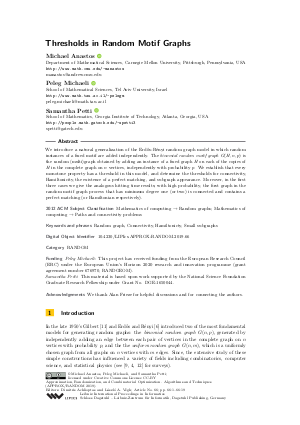Thresholds in Random Motif Graphs
Authors
Michael Anastos  ,
Peleg Michaeli
,
Peleg Michaeli  ,
Samantha Petti
,
Samantha Petti 
-
Part of:
Volume:
Approximation, Randomization, and Combinatorial Optimization. Algorithms and Techniques (APPROX/RANDOM 2019)
Part of: Series: Leibniz International Proceedings in Informatics (LIPIcs)
Part of: Conference: International Conference on Randomization and Computation (RANDOM)
Part of: Conference: International Conference on Approximation Algorithms for Combinatorial Optimization Problems (APPROX) - License:
 Creative Commons Attribution 3.0 Unported license
Creative Commons Attribution 3.0 Unported license
- Publication Date: 2019-09-17
File

PDF
LIPIcs.APPROX-RANDOM.2019.66.pdf
- Filesize: 0.56 MB
- 19 pages
Document Identifiers
Subject Classification
ACM Subject Classification
- Mathematics of computing → Random graphs
- Mathematics of computing → Paths and connectivity problems
Keywords
- Random graph
- Connectivity
- Hamiltonicty
- Small subgraphs
Metrics
- Access Statistics
-
Total Accesses (updated on a weekly basis)
0Document
0Metadata
Abstract
We introduce a natural generalization of the Erdős-Rényi random graph model in which random instances of a fixed motif are added independently. The binomial random motif graph G(H,n,p) is the random (multi)graph obtained by adding an instance of a fixed graph H on each of the copies of H in the complete graph on n vertices, independently with probability p. We establish that every monotone property has a threshold in this model, and determine the thresholds for connectivity, Hamiltonicity, the existence of a perfect matching, and subgraph appearance. Moreover, in the first three cases we give the analogous hitting time results; with high probability, the first graph in the random motif graph process that has minimum degree one (or two) is connected and contains a perfect matching (or Hamiltonian respectively).
Cite As Get BibTex
Michael Anastos, Peleg Michaeli, and Samantha Petti. Thresholds in Random Motif Graphs. In Approximation, Randomization, and Combinatorial Optimization. Algorithms and Techniques (APPROX/RANDOM 2019). Leibniz International Proceedings in Informatics (LIPIcs), Volume 145, pp. 66:1-66:19, Schloss Dagstuhl – Leibniz-Zentrum für Informatik (2019)
https://doi.org/10.4230/LIPIcs.APPROX-RANDOM.2019.66
BibTex
@InProceedings{anastos_et_al:LIPIcs.APPROX-RANDOM.2019.66,
author = {Anastos, Michael and Michaeli, Peleg and Petti, Samantha},
title = {{Thresholds in Random Motif Graphs}},
booktitle = {Approximation, Randomization, and Combinatorial Optimization. Algorithms and Techniques (APPROX/RANDOM 2019)},
pages = {66:1--66:19},
series = {Leibniz International Proceedings in Informatics (LIPIcs)},
ISBN = {978-3-95977-125-2},
ISSN = {1868-8969},
year = {2019},
volume = {145},
editor = {Achlioptas, Dimitris and V\'{e}gh, L\'{a}szl\'{o} A.},
publisher = {Schloss Dagstuhl -- Leibniz-Zentrum f{\"u}r Informatik},
address = {Dagstuhl, Germany},
URL = {https://drops.dagstuhl.de/entities/document/10.4230/LIPIcs.APPROX-RANDOM.2019.66},
URN = {urn:nbn:de:0030-drops-112819},
doi = {10.4230/LIPIcs.APPROX-RANDOM.2019.66},
annote = {Keywords: Random graph, Connectivity, Hamiltonicty, Small subgraphs}
}
Author Details
- Department of Mathematical Sciences, Carnegie Mellon University, Pittsburgh, Pennsylvania, USA
Funding
- Michaeli, Peleg: This project has received funding from the European Research Council (ERC) under the European Union’s Horizon 2020 research and innovation programme (grant agreement number 676970, RANDGEOM).
- Petti, Samantha: This material is based upon work supported by the National Science Foundation Graduate Research Fellowship under Grant No. DGE-1650044.
Acknowledgements
We thank Alan Frieze for helpful discussions and for connecting the authors.
References
-
Noga Alon and Joel H. Spencer. The probabilistic method. Wiley Series in Discrete Mathematics and Optimization. John Wiley & Sons, Inc., Hoboken, NJ, fourth edition, 2016.

-
Uri Alon. Network motifs: theory and experimental approaches. Nature Reviews Genetics, 8(6):450-461, 2007.

- Albert-László Barabási and Réka Albert. Emergence of scaling in random networks. Science, 286(5439):509-512, 1999. URL: https://doi.org/10.1126/science.286.5439.509.
-
Béla Bollobás. Random graphs. Academic Press, Inc. [Harcourt Brace Jovanovich, Publishers], London, 1985.

- Béla Bollobás and Andrew Thomason. Hereditary and monotone properties of graphs. In The mathematics of Paul Erdős, II, volume 14 of Algorithms Combin., pages 70-78. Springer, Berlin, 1997. URL: https://doi.org/10.1007/978-3-642-60406-5_7.
-
Paul Erdős and Alfréd Rényi. On random graphs. I. Publicationes Mathematicae Debrecen, 6:290-297, 1959.

-
Paul Erdős and Alfréd Rényi. On the evolution of random graphs. Magyar Tud. Akad. Mat. Kutató Int. Közl., 5:17-61, 1960.

- Alan Frieze, Navin Goyal, Luis Rademacher, and Santosh Vempala. Expanders via random spanning trees. SIAM Journal on Computing, 43(2):497-513, 2014. URL: https://doi.org/10.1137/120890971.
- Alan Frieze and Michał Karoński. Introduction to random graphs. Cambridge University Press, Cambridge, 2016. URL: https://doi.org/10.1017/CBO9781316339831.
- Alan Frieze, Michał Karoński, and Luboš Thoma. On perfect matchings and Hamilton cycles in sums of random trees. SIAM Journal on Discrete Mathematics, 12(2):208-216, 1999. URL: https://doi.org/10.1137/S0895480196313790.
- Edgar N. Gilbert. Random graphs. Annals of Mathematical Statistics, 30:1141-1144, 1959. URL: https://doi.org/10.1214/aoms/1177706098.
- Svante Janson, Tomasz Łuczak, and Andrzej Rucinski. Random graphs. Wiley-Interscience Series in Discrete Mathematics and Optimization. Wiley-Interscience, New York, 2000. URL: https://doi.org/10.1002/9781118032718.
-
Michael Krivelevich and Peleg Michaeli. Small subgraphs in the trace of a random walk. Electronic Journal of Combinatorics, 24(1):Paper 1.28, 22, 2017.

-
Ron Milo, Shai Shen-Orr, Shalev Itzkovitz, Nadav Kashtan, Dmitri B. Chklovskii, and Uri Alon. Network motifs: simple building blocks of complex networks. Science, 298(5594):824-827, 2002.

- Samantha Petti and Santosh S. Vempala. Approximating Sparse Graphs: The Random Overlapping Communities Model. arXiv e-prints, February 2018. URL: http://arxiv.org/abs/1802.03652.
-
Daniel Poole. On the strength of connectedness of a random hypergraph. Electronic Journal of Combinatorics, 22(1):Paper 1.69, 16, 2015.

-
Sen Song, Per Jesper Sjöström, Markus Reigl, Sacha B. Nelson, and Dmitri B. Chklovskii. Highly nonrandom features of synaptic connectivity in local cortical circuits. PLoS biology, 3(3):e68, 2005.

- Duncan J. Watts and Steven H. Strogatz. Collective dynamics of "small-world" networks. Nature, 393(6684):440-442, 1998. URL: https://doi.org/10.1038/30918.
-
Nicholas C. Wormald. Models of random regular graphs. In Surveys in combinatorics, 1999 (Canterbury), volume 267 of London Math. Soc. Lecture Note Ser., pages 239-298. Cambridge Univ. Press, Cambridge, 1999.

-
Esti Yeger-Lotem, Shmuel Sattath, Nadav Kashtan, Shalev Itzkovitz, Ron Milo, Ron Y. Pinter, Uri Alon, and Hanah Margalit. Network motifs in integrated cellular networks of transcription-regulation and protein-protein interaction. Proceedings of the National Academy of Sciences of the United States of America, 101(16):5934-5939, 2004.

